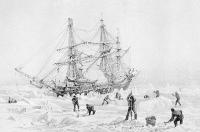 Researchers have published the results of their analysis of DNA from 24 individuals who died on the ill-fated Franklin Northwest Passage Expedition. Surprisingly, four of the 24 individuals appear to be European women, based on DNA markers. Were there women in the Franklin expedition? Perhaps, but likely not.
Researchers have published the results of their analysis of DNA from 24 individuals who died on the ill-fated Franklin Northwest Passage Expedition. Surprisingly, four of the 24 individuals appear to be European women, based on DNA markers. Were there women in the Franklin expedition? Perhaps, but likely not.
Franklin’s expedition set off on the H.M.S. Erebus and the H.M.S. Terror in 1845 heading to Arctic Canada to look for the fabled route between the Atlantic and the Pacific. By 1846, Franklin and his 129 crew members were iced in. Though the expedition was stocked with enough food to last for several years, none of officers or crew on the expedition survived.
Since roughly the 1980s, researchers have been collecting samples of bones and teeth believed to be from the Franklin crew, found near the believed wreck sites of the Franklin’s ships. Recently, a team led by Douglas Stenton of Nunavut’s Department of Culture and Heritage has been doing groundbreaking analysis of theses samples. In a paper, DNA analysis of human skeletal remains from the 1845 Franklin expedition published in Journal of Archaeological Science, Stenten and his co-authors reveal that of the 37 samples from which DNA could be sampled, there were 24 individuals represented. And surprisingly, four of the samples appear to be women.
Really? Maybe not. As reported by Live Science:
Stenton and his colleagues think the most likely explanation for this discrepancy is that ancient DNA studies commonly fail to amplify the Y chromosome (the male sex chromosome) due to insufficient quantity or quality of DNA, which can result in false female identifications of the dead. However, the researchers noted that it wasn’t unheard of for women to serve in disguise in the Royal Navy.
“Some of these women were smuggled onboard [the] ship, and others disguised themselves as men and worked alongside the crew for months or years before being detected or intentionally revealing themselves to be female,” the authors wrote.
They cited cases such as Mary Anne Talbot, who served on two Navy ships during the Napoleonic wars of the 18th century before being found out after being wounded. Unfortunately, Stenton said he doesn’t think it will be possible to definitively say whether the four Franklin samples are really just false results, but his team concluded that it would have been very unlikely for so many women to be serving secretly on this voyage.

Thanks for bringing these findings to light. Why the team thought it would be very unlikely for so many women to be serving secretly on this voyage puzzles me. That’s purely an assumption. Not to mention warrant officers often kept wives aboard, as the ship was their home. Still, the point is well taken that the sex of the four can’t be determined for certain by present methods.
Another aspect:
Talks with British on ownership of Franklin artifacts still unresolved.
U.K. to get 1st major exhibition of Franklin relics from HMS Erebus as talks drag on.
http://www.cbc.ca/news/politics/hms-erebus-terror-franklin-expedition-wrecks-parks-canada-inuit-1.4099544
I think the reason that there are doubts about the number of women aboard is that the Franklin expedition was fairly high profile and the names and backgrounds of the crew are thought to be reasonably documented by existing muster rolls and various diaries that have been recovered. The known false positives from degraded DNA seem the more likely explanation for the results than the presence of women in hiding on the two ships. but as you say, one can never know.